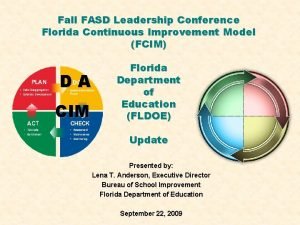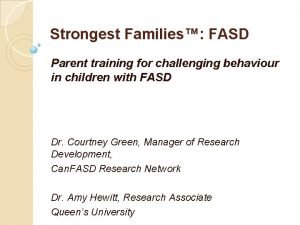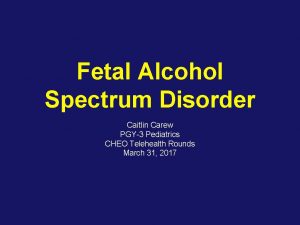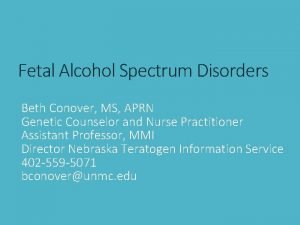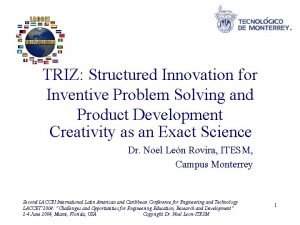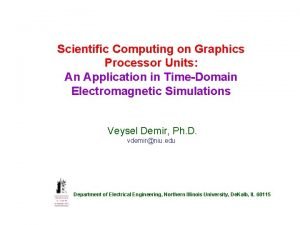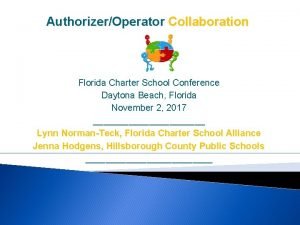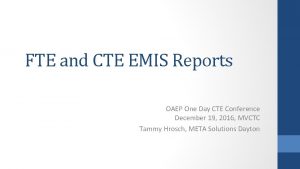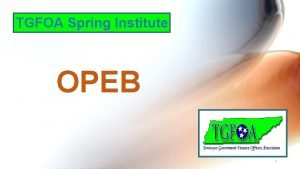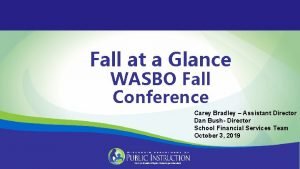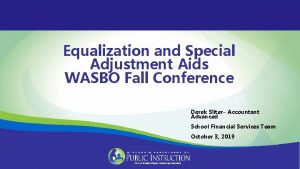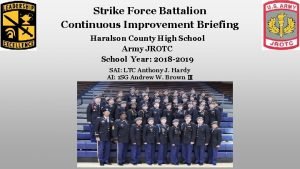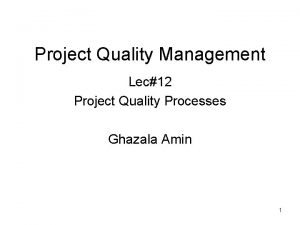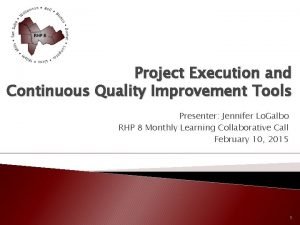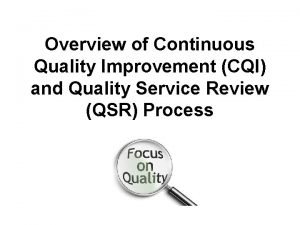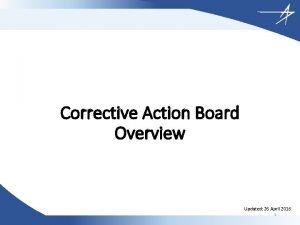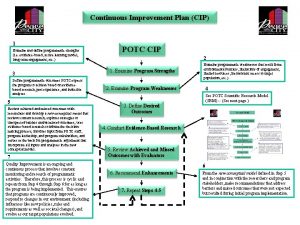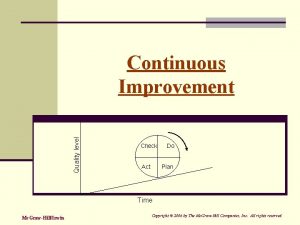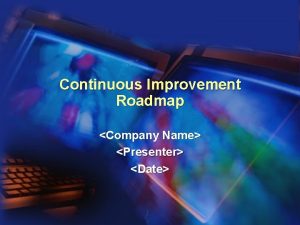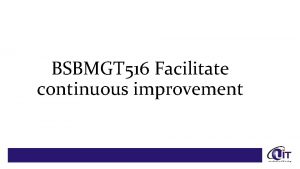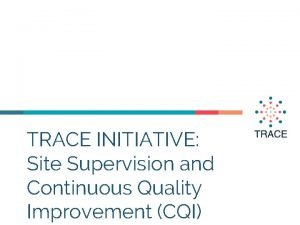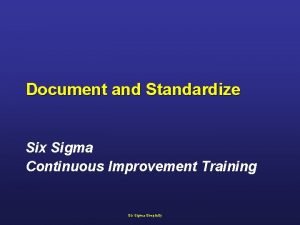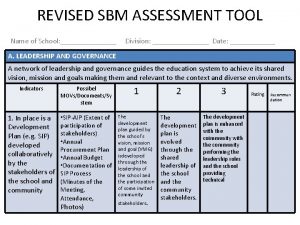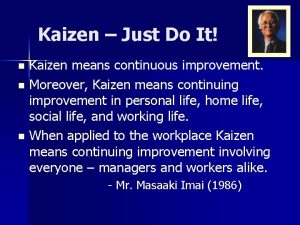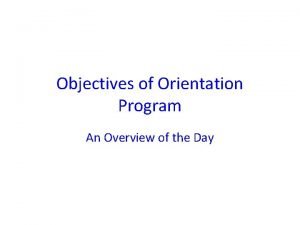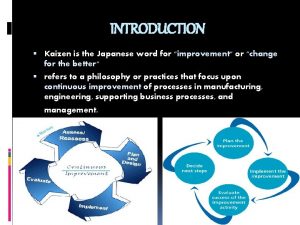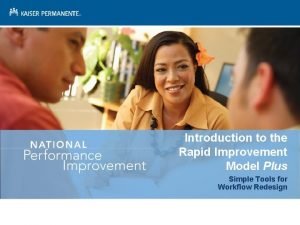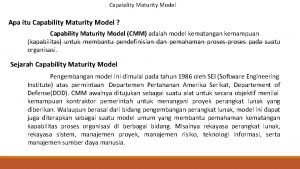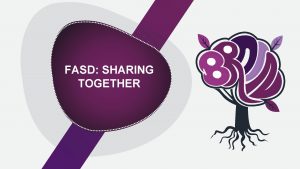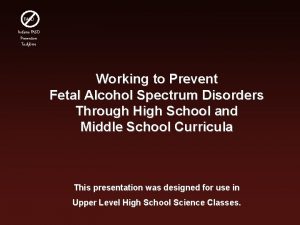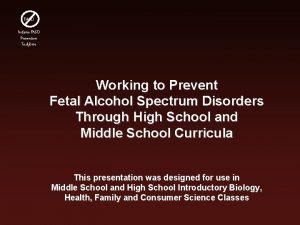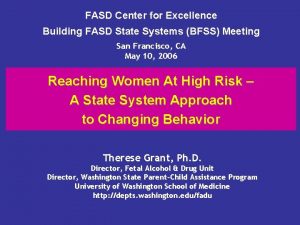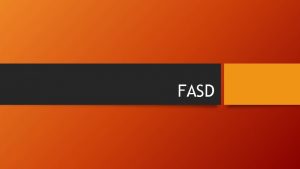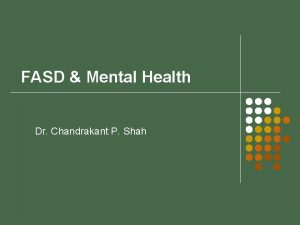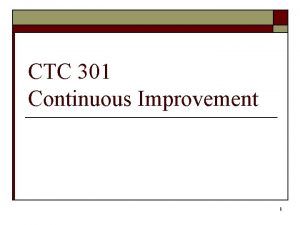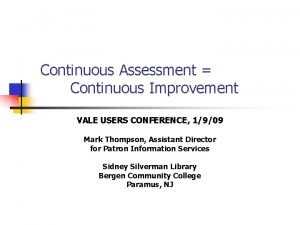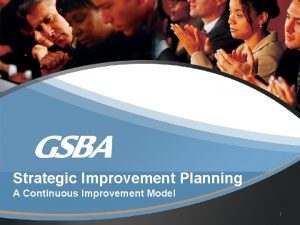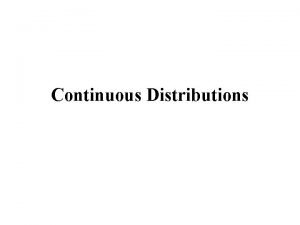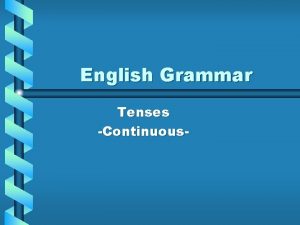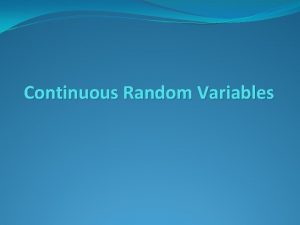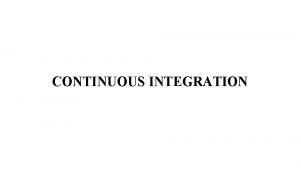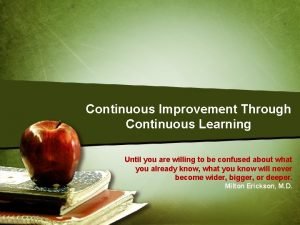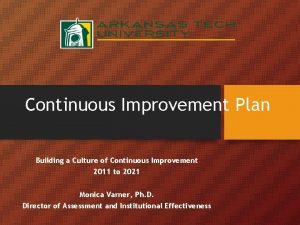Fall FASD Leadership Conference Florida Continuous Improvement Model




































- Slides: 36

Fall FASD Leadership Conference Florida Continuous Improvement Model (FCIM) DA CIM Florida Department of Education (FLDOE) Update Presented by: Lena T. Anderson, Executive Director Bureau of School Improvement Florida Department of Education September 22, 2009

n. Common board configuration KEYS TO SUCCESS (Date, Agenda, Benchmark, Objective, Homework) n. Use of a bell ringer or opening activity n. Bell to Bell Instruction n. Procedures and Routines are established. n. Lesson planning is clear and implemented. n. Multiple activities taking place throughout the lesson. n. Writing and Reading are integrated in all subject areas. n. Teachers provide multiple examples to ensure student understanding. n. Graphic organizers are used to capture and explain concepts. n. Students are THINKING, DISCUSSING, QUESTIONING. n. Higher Order Questions are used consistently and naturally.

§Notebook for writing and vocabulary (includes reading, mathematics, and science). §Notebook and schedule for science labs. KEYS TO SUCCESS §Students raise their hands. Wait time is given. Continued §Benchmarks are explicitly taught and unwrapped for students. §Data is used to differentiate instruction. §Manipulatives are used in mathematics and science. §Students are discussing the text in reading and language arts classes. §Limited use of worksheets and textbook. §Assigning work vs. teaching is understood.

KEYS TO SUCCESS Continued § § § Work and concepts are taught at grade level. Projects are not frothy. Coloring is limited in primary grades. Movies support instruction. Immediate feedback is provided for student work. Rubrics are used to grade assignments. Model work is identified. § Vocabulary is explicitly taught with word walls (all content areas) § Writing process must include (frequent prompts, graded by teachers AND students, constant use of rubric by teachers AND students). Store student work.

Florida Continuous Improvement Model (FCIM)

Data Disaggregation: In this step teachers and administrators disaggregate, or analyze, the state standards assessment and/or standardized test data to identify both students' and teachers' strengths and weaknesses and to improve teacher instruction and student learning. Focusing on specific student weaknesses, the teachers and administrators create a plan for student improvement. Identifying teachers' strengths and weaknesses enables administrators to provide effective quality staff development to improve instruction and student learning.

Calendar Development: Based on the students' strengths and weaknesses, teachers build an instructional calendar that includes all the standards/skills to be assessed. Supplemental activities such as learning centers and computer activities (FCAT Explorer, Achieves/FOCUS, ) reinforce the standards, skills, and concepts. Cooperative learning and hands-on activities are utilized to supplement or reinforce lessons. Follow-up activities are utilized to check for comprehension and to monitor progress. The calendar allows for teaching whole group lessons in addition to small group lessons where instruction is differentiated according to individual student needs. Student groups are fluid and flexible. Home work is aligned to class work (whole or small group lessons) and supports skills and concepts previously taught.

Direct the Instructional Focus: Based on the instructional calendar, teachers teach the targeted skill. The goal here is for quality instruction and student mastery. Classroom activities should be focused and conducive to learning by: • highlighting the FCAT Focus and Daily Objective • utilizing Focus Lessons aligned to annually assessed benchmarks • Posing Higher Order Questions • varying the instructional delivery methods (visual, auditory, kinesthetic, tactile) • Incorporating vocabulary, word walls, journals, literature, technology, hands-on activities, centers, use of manipulatives and materials, cooperative learning

Focus Lessons: • Aligned to Annually Assessed Benchmarks • Presents in correlating Item Formats Direct the Instructional Focus (continued): MC, GR, SR, ER Reading Mathematics Science Effective teaching strategies for instruction have at their core, consistently high-level expectations for students. Additionally, quality instruction includes: • Utilizing “common board configuration to identify for students the benchmark, objective, and agenda • providing essential vocabulary for subject area • applying learning to the real world • using cooperative learning techniques • using skill reinforcing drills • teaching test-taking strategies • celebrating mastery of skills and knowledge

Assessment: FCAT Explorer and FOCUS Achieves Assessments: After teaching the targeted skill, teachers administer a short assessment to check for student understanding. These assessments should be integrated into the curriculum and instruction. The assessments should mimic the format of the state standards assessment. Teacher teams should meet frequently to review assessment results. Mini-Assessments Administered at School-Site at Teacher Discretion : • Computer-Based • Free to all public schools • Immediate access to student data • Teacher controls “opening” and “closing” of mini-assessments • Teacher discretion (Daily, Weekly)

Achieve/FOCUS Assessments School site-based computer-based mini-assessments

Achieve/FOCUS Assessments Teachers determine when to “open” assessments

Maintenance: Teachers, paraprofessionals, and Instructional Coaches must continuously work to reinforce skills and knowledge until they become part of the student's knowledge base. Monitoring: School principals and the instructional coordinator assume the primary responsibility for monitoring program success. Monitoring practices include regularly unscheduled classroom visits, one-on-one meetings with students and teachers to review test scores, celebrating successes, using surveys to assess the process, the school climate, and stakeholder satisfaction.

Tutorials and Enrichment: Based on assessment results, teachers should provide continuing quality instruction to either build on success or provide additional instruction. Teaching teams should work together to review progress. Extensions must be considered as important as tutorial work and provided for both mastery and non-mastery students. Additional assessments may be given to check mastery.

FCIM DA CIM Assistance Plus Monitoring Student Centered Differentiated Accountability Monitoring and Support Student and Teacher Centered Plan • Data Disaggregation • Instructional Focus Calendar Do • Instructional Focus Check • Mini-Assessment • Maintenance • Monitoring Act • Tutorials • Enrichment Plan • FCAT Analysis • DART 2009 • FCAT Test Design • FCAT Content Focus • FCAT Item Specifications Do • Instructional Pacing Calendar • Instructional Delivery Guide Check • Assessments • Data Disaggregation • Maintenance • Monitoring Act • Lesson Study • Differentiated Instruction • Professional Development

D A CIM

D A Instructional Pacing Calendar CIM Essential Tools for Assigning Instructional Days • FCAT Test Design Document- provides the approximate percentage of raw score points derived from each content category. • Example

Instructional Pacing Calendar CA N G Content Focus Points Possibl e 04 Points Possibl e 05 Points Possibl e 06 Points Possible '07 Points Possible '08 Points Possibl e '09 Benchmark Explanation 2004 -2009 Content Focus Matrix- provides the amount of points each skill was assigned from 2004 to 2009. Physical and Chemical Sciences A 121 A 122 A 123 A 124 Grade 5 Tools 1 1 1 Mass 1 Density 1 1 1 Measurement 1 Phase changes 2 1 Total weight 1 2 Conservation of Mass 1 1 The student identifies how a change in temperature can alter a material's state of matter. Conservation of Mass 1 The student combines the weight or mass of components to get the total weight/mass of the combined object. Solutions 1 1 1 Mixtures 1 The student identifies properties and uses appropriate tools to determine the properties of materials. The student identifies different materials made by physically combining substances and/or identifies similarities and differences between mixtures and solutions.

Instructional Delivery Guide D A Page 1 CIM Science VOCABULARY WORDS SUGGESTED OPENING ACTIVITY Journal Activities , Vocabulary Activities, Demonstrations, Science Trivia, http: //sciencespot. net/Pages/starterschem. html TEACHER PREFERRED OPENING ACTIVITY MTWRF- Use the Word Wall to introduce new words and to recall past words Communication Energy Experiment Heat Infer Investigation Model Records/Record Replication Scientific Method Observation Variable Math SUGGESTED OPENING ACTIVITY Journal Activities Graphic Organizers Vocabulary Activities Fold-ables TEACHER PREFERRED OPENING ACTIVITY MTWRF- Reading- N/A VOCABULARY WORDS

D A CIM Instructional Delivery Guide Page 1 Reading, Mathematics, and Science Lesson Objectives/Benchmarks Aligned to Test Item Specifications LESSON OBJECTIVES BENCHMARK M and T: The student understands the relative size of whole numbers, commonly used fractions, decimals, and percents. W and R: The student understands that numbers can be represented in a variety of equivalent forms using whole numbers, decimals, fractions, and percents. F: *Refer to objectives listed M-R

D A Instructional Delivery Guide CIM Page 1 Reading, Mathematics, and Science Essential Question- is asked at the beginning of class/lesson. Students should be able to answer the question at the end of the class/lesson. Example: How are the elements of the periodic table arranged? ESSENTIAL QUESTIONS Asked at the beginning of the lesson, Answered by the end of the lesson MTWRF-

D A CIM Instructional Delivery Guide Higher Order Questions. Promotes higher order thinking from students, and encourages teachers to ask questions that are aligned to moderate and high FCAT complexity levels. HIGHER ORDER QUESTIONS Webb’s DOK/ FCAT Task Cards

D A CIM Instructional Delivery Guide Page 1 Reading, Mathematics, and Science Whole Group/Core Instruction- includes suggested whole group lesson/activities. This area also includes a section for textbook alignment. *This area has been left blank for all grade levels in reading, and for all high school mathematics and science courses. WHOLE GROUP/CORE INSTRUCTION Daily Lesson: Textbook Correlation and/or Supplemental Activities M and T- http: //classroom. springisd. org/webs/sjacks 5/upload/science_safety_symbols. pdf Shows students pictures of Science Lab Safety Symbols and have students demine what they mean and give scenarios. W- Read and discuss question with students http: //www. educationworld. com/a_curr/curr 295. shtml R and F- Have students compare the meanings of the words they defined and determine if the field of Science uses it differently that everyday language. Align to Model Lesson and/or Focus Lesson: Teach Pre-Requisite Skills, Provide Skill Practice, Utilize Skill Re-Enforcement Activities M-Textbook Page(s) #: Activity/Lesson: T-Textbook Page(s) # Activity/Lesson: W-Textbook Page(s) #: Activity/Lesson:

D A CIM Instructional Delivery Guide Page 1 Reading, Mathematics, and Science Homework- is divided into two sections. One section includes suggested homework assignments and the other section is left blank for “teacher preferred” homework assignments. HOMEWORK SUGGESTIONS Aligned to Whole Group/Core instruction (indicate which strategy will be used) Computational Practice, Vocabulary, Graphic Organizer TEACHER PREFERRED HOMEWORK ASSIGNMENT (Aligned to Whole Group/Core Instruction) MTWRF-

D A Instructional Delivery Guide CIM Page 2 DATA-DRIVEN Differentiated Instruction Reading, Mathematics, and Science Indicate by circling below, which data will be utilized to plan Differentiated Instruction: (Please include the data in your Data Binder). 2009 FCAT Data Baseline Data FCIM Monthly Data-Driven Differentiated Instructionbased on formative and summative data. Accommodations/Modificationsare to be used with ALL students. Other________ ACCOMMODATIONS http: //www. cpt. fsu. edu/ese/

Data Disaggregation Analyze data results to differentiate instruction

Data Disaggregation FCAT Data by student m

Data Disaggregation FCAT Data by teacher

Instructional Delivery Guide D A Page 2 CIM Reading, Mathematics, and Science Differentiated Instruction- a vital part of instructional planning that addresses the diversity of learners, and allows teachers the opportunity to address individual students’ strengths and weaknesses. DIFFERENTIATED INSTRUCTION Small Group: Intensive DIFFERENTIATED INSTRUCTION Small Group: Proficiency DIFFERENTIATED INSTRUCTION Small Group: Enrichment Assignment(s): ________________________________ _______________________________ Student(s): 1. ___________________ 2. ___________________ 3. ___________________ 4. ___________________ 5. ___________________ 6. ___________________ 1. __________ 2. __________ 3. __________ 4. __________ 5. __________ 6. __________

D A CIM Instructional Delivery Guide Page 2 Reading, Mathematics, and Science Literature Connections/ Cross-curricular Activitiesprovides a connection between content areas and reinforces skills needed in other subject areas. LITERATURE CONNECTIONS and CROSS CURRICULAR ACTIVITIES (Reading, Mathematics, Science) *Utilize Literature Connection Guide for Mathematics

D A CIM Instructional Delivery Guide Page 2 Reading, Mathematics, and Science Learning Centers/Labs (cooperative learning)- provides teachers the opportunity to differentiate instruction (remediation, reinforcement and/or enrichment) of a CENTERS, LABS skill/concept. (COOPERATIVE LEARNING) “Vitamin C Versus Oxygen “Salty Water Experiment” - http: //www. sciencenewsforkids. com/articles/20060329/LZActivity. asp

D A CIM Instructional Delivery Guide Page 2 Reading, Mathematics, and Science Closing Activity- encourages bell-to-bell instruction and offers a form of assessment. Suggested closing activities are provided with space available for “teacher preferred” closing activities. CLOSING ACTIVITY Exit Cards, Journal Entries, Vocabulary, Graphic Organizers, Lesson Review MTWRF-

D A CIM Instructional Delivery Guide Page 2 Reading, Mathematics, and Science Assessment/Progress Monitoring. ASSESSMENT Progress Monitoring Via teacher discretion, please utilize the mini-assessments (classroom computers or computer lab) provided through Florida Achieves!: http: //fcatexplorer. com/ FCIM Monthly Assessment

D A CIM Instructional Delivery Guide Page 3 Reading, Mathematics, and Science Technology- provides resources that will enhance the curriculum. TECHNOLOGY/ INTERNET http: //www. fldoestem. org/cen ter 13. aspx http: //fldifferentiatedaccounta bility. org/home http: //school. discoveryeducati on. com/ http: //www. fi. edu/tfi/activity/

D A CIM Instructional Delivery Guide Page 3 Reading, Mathematics, and Science Benchmark Clarifications, FCAT Item Specification, and FCAT Item Type- Depending on the grade level being taught, teachers will be provided with the NGSSS. ITEM SPECIFICATIONS BENCHMARK CLARIFICATIONS MAA 122 Benchmark: The student understands the relative size of whole numbers, commonly used fractions, decimals, and percents. FCAT Item Type(s) ITEM SPECIFICATIONS CONTENT LIMITS MAA 122: Numbers being compared may be in the same form or in two different forms. In items comparing fractions with decimals: MAA 122 Benchmark Clarification: Students will compare relative size and order of whole numbers, fractions and decimals. The denominator of the fraction should represent the same number of places as the decimal. For example, 0. 40 = 40/100 and 0. 4 = 4/10.

D A CIM Contact Information Lena T. Anderson 850 -245 -0007 lena. anderson@fldoe. org Elan Pace Shakira Pompey Katrice Green 850 -245 -0855 850 -245 -0822 245 -9183 elan. pace@fldoe. org shakira. pompey@fldoe. org katrice. green@fldoe. org Florida Department of Education Turlington Building 325 West Gaines Street Room 314 Tallahassee, FL 32399 Websites Florida Department of Education- www. fldoe. org 850 -
 Florida continuous improvement model
Florida continuous improvement model Fasd behavior checklist
Fasd behavior checklist Fasd
Fasd Adult with fetal alcohol syndrome
Adult with fetal alcohol syndrome Past continuous future tense
Past continuous future tense Future simple in the past
Future simple in the past Conference in florida
Conference in florida Conference in florida
Conference in florida Florida charter school conference
Florida charter school conference Oaep fall conference
Oaep fall conference Tgfoa
Tgfoa Wasbo fall conference
Wasbo fall conference Wasbo fall conference
Wasbo fall conference Njdv
Njdv Charlie company mottos jrotc
Charlie company mottos jrotc Continuous improvement
Continuous improvement Continuous quality improvement plan example
Continuous quality improvement plan example Define continuous quality improvement
Define continuous quality improvement 4 blocker
4 blocker Cip 1
Cip 1 Continuous improvement check sheet
Continuous improvement check sheet Itil 7 step continuous improvement process
Itil 7 step continuous improvement process Continuous improvement roadmap
Continuous improvement roadmap Bsbmgt516 facilitate continuous improvement
Bsbmgt516 facilitate continuous improvement Cqi action plan template
Cqi action plan template Continuous improvement documentation
Continuous improvement documentation Parents opennionaire
Parents opennionaire Just do it kaizen
Just do it kaizen Objectives of orientation program for students
Objectives of orientation program for students Japanese word for continuous improvement
Japanese word for continuous improvement Bpa state leadership conference texas
Bpa state leadership conference texas Transactional vs transformational leadership
Transactional vs transformational leadership Adaptive management style
Adaptive management style Situational leadership vs adaptive leadership
Situational leadership vs adaptive leadership Rapid cycle improvement model
Rapid cycle improvement model Capability maturity model improvement digunakan pada bagian
Capability maturity model improvement digunakan pada bagian Pdsa cycles
Pdsa cycles
